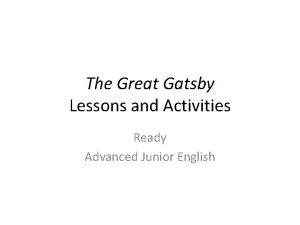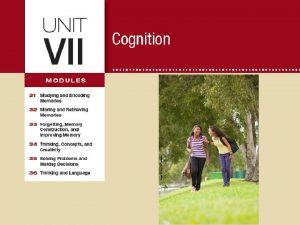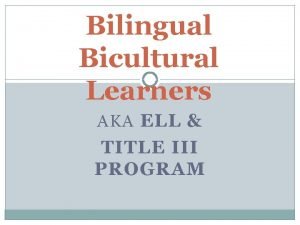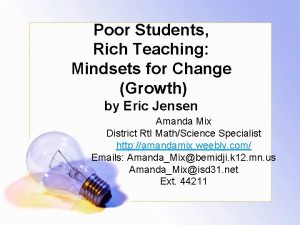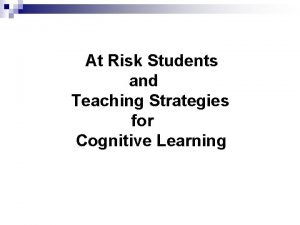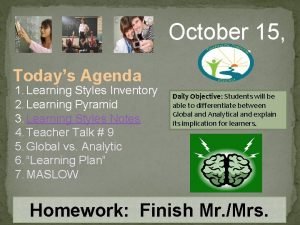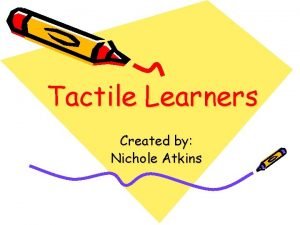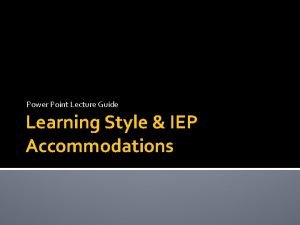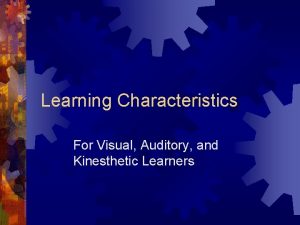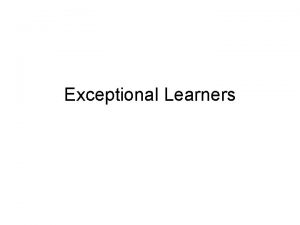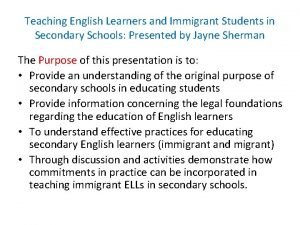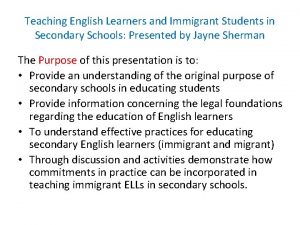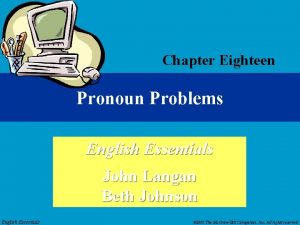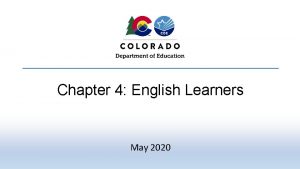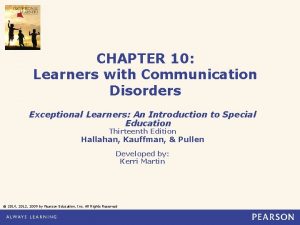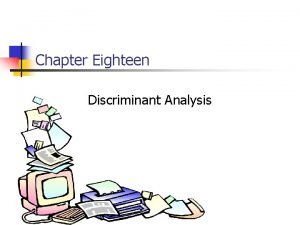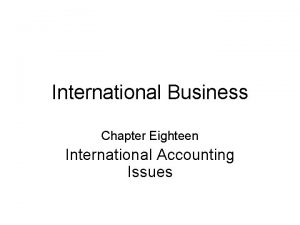CHAPTER EIGHTEEN TEACHING ENGLISH LEARNERS Teaching Students with

















- Slides: 17

CHAPTER EIGHTEEN TEACHING ENGLISH LEARNERS Teaching Students with Special Needs in General Education Classrooms, 8 e Lewis/Doorlag ISBN: 0136101240 © 2011 Pearson Education, Inc. All rights reserved.

ENGLISH LEARNERS n The National Clearinghouse for English Language Acquisition and Language Instruction Educational Program (2007 a) reports that more than 350 languages are spoken by English learners in the U. S. schools. The top five languages are Spanish (accounting for more than three-quarters of English learners), Vietnamese, Hmong, Korean, and Arabic. Teaching Students with Special Needs in General Education Classrooms, 8 e Lewis/Doorlag ISBN #0136101240 2 © 2011 Pearson Education, Inc. All rights reserved.

English Learners (cont’d) n Data from the 2006 American Community Survey indicate that 10. 4 million or 20. 2% of U. S. school children ages 5 -17 spoke languages other than English at home. Of these, approximately 2. 5 million were identified as speaking English “less than very well. ” Teaching Students with Special Needs in General Education Classrooms, 8 e Lewis/Doorlag ISBN #0136101240 3 © 2011 Pearson Education, Inc. All rights reserved.

English Learners (cont’d) n n According to the National Center for Education Statistics (2006), in the 20032004 school year, 3. 8 million students or 11% of all students received English language learner (ELL) services. In 2008 -2009, 33 of the 50 states had teaching standards for ELL (cont’d) Teaching Students with Special Needs in General Education Classrooms, 8 e Lewis/Doorlag ISBN #0136101240 4 © 2011 Pearson Education, Inc. All rights reserved.

English Learners (cont’d) n n … instruction, but only three require prospective educators to demonstrate competence in this area (National Center for Education Statistics, 2009). According to one prediction, by 2020, more than 30% of U. S. students will come from homes where the primary language is not English. Teaching Students with Special Needs in General Education Classrooms, 8 e Lewis/Doorlag ISBN #0136101240 5 © 2011 Pearson Education, Inc. All rights reserved.

English Learners (cont’d) n In a recent report, the National Clearinghouse for English Language Acquisition reported these statistics about English language learners. The number of students in this group has increased by more than 50% in the last decade, almost 60% of English language learners qualify for free or reduced cost lunch, and “eighth grade ELL’s scores are less than half those of English speaking peers on tests of reading and mathematics. ” Teaching Students with Special Needs in General Education Classrooms, 8 e Lewis/Doorlag ISBN #0136101240 6 © 2011 Pearson Education, Inc. All rights reserved.

English Learners (cont’d) n Bank Street College of Education (n. d. ) says that “While the speakers of those languages may be all ages, come from a wide range of ethnic backgrounds, from different economic situations, and may have come to this country for a variety of reasons, they all have in common the desire to learn English. ” Teaching Students with Special Needs in General Education Classrooms, 8 e Lewis/Doorlag ISBN #0136101240 7 © 2011 Pearson Education, Inc. All rights reserved.

INDICATORS OF THE NEED FOR ENGLISH LANGUAGE INSTRUCTION n n If parents indicate that a language other than English is spoken at home, this alerts the school to the possibility that the student also speaks this language. When this occurs, parents are asked to complete a language background survey or participate in an interview. Parents can provide information about the child’s heritage language or home language. Teaching Students with Special Needs in General Education Classrooms, 8 e Lewis/Doorlag ISBN #0136101240 8 © 2011 Pearson Education, Inc. All rights reserved.

IDENTIFICATION AND ASSESSMENT PROCEDURES n n Identification of students in need of English language instruction requires determination of language proficiency in English as well as in any other languages spoken. This may take place at the entry to school or as part of Response to Intervention if students experience difficulty in school. Duran (2008) reported that all states rely on home language surveys to identify (cont’d) Teaching Students with Special Needs in General Education Classrooms, 8 e Lewis/Doorlag ISBN #0136101240 9 © 2011 Pearson Education, Inc. All rights reserved.

Identification and Assessment Procedures (cont’d) n n …students who live in homes where a language other than English is spoken; in most cases, students from such homes are then assessed to determine which initial classification is most appropriate: English proficient or English language learner. Assessments: n n Formal measures Informal observations Teaching Students with Special Needs in General Education Classrooms, 8 e Lewis/Doorlag ISBN #0136101240 10 © 2011 Pearson Education, Inc. All rights reserved.

SERVICES FOR ENGLISH LEARNERS n n Services vary widely from state to state and district to district. Bilingual education programs that include both heritage language and English instruction have become less common, and programs focusing on English language development have become more common. Teaching Students with Special Needs in General Education Classrooms, 8 e Lewis/Doorlag ISBN #0136101240 11 © 2011 Pearson Education, Inc. All rights reserved.

Types of Program Options Available Today for English Learners n n n Sheltered instruction Transitional bilingual education Developmental bilingual education Two-way immersion Newcomer programs Teaching Students with Special Needs in General Education Classrooms, 8 e Lewis/Doorlag ISBN #0136101240 12 © 2011 Pearson Education, Inc. All rights reserved.

CLASSROOM ADAPTATIONS n n Principles of culturally responsive instruction Principles of language instruction Building English vocabulary Teaching content area subjects Teaching Students with Special Needs in General Education Classrooms, 8 e Lewis/Doorlag ISBN #0136101240 13 © 2011 Pearson Education, Inc. All rights reserved.

THINGS TO REMEMBER n n n English learners come to school speaking the family’s heritage language; they may know little, some, or no English. In U. S. schools, more than 350 languages other than English are spoken by students. When languages other than English are spoken at home, families take part in home language surveys or interviews to help schools understand students’ language prowess in English and the heritage language or languages. Teaching Students with Special Needs in General Education Classrooms, 8 e Lewis/Doorlag ISBN #0136101240 14 © 2011 Pearson Education, Inc. All rights reserved.

THINGS TO REMEMBER (cont’d) n n n Proficiency in a language must include basic interpersonal communication skills and cognitive/academic learning proficiency. The most common program option today for English learners is sheltered instruction; bilingual education programs have become less popular, in part because of the increase in the number of languages spoken in any one school. The principles of culturally responsive instruction apply to the education of English learners and to that of their general education peers. Teaching Students with Special Needs in General Education Classrooms, 8 e Lewis/Doorlag ISBN #0136101240 15 © 2011 Pearson Education, Inc. All rights reserved.

THINGS TO REMEMBER (cont’d) n n Effective instruction for English learners shares the same characteristics as effective instruction for all students; however, teachers must also make adaptations because of students’ needs in the area of English language learning. Strategies for building English vocabulary include teaching vocabulary directly; providing opportunities for practice; techniques such as gesturing, the use of visuals and real objects, and modeling and demonstrations; and in the first stages of language learning, allowing students to respond by pointing, drawing, or some other non-verbal technique. Teaching Students with Special Needs in General Education Classrooms, 8 e Lewis/Doorlag ISBN #0136101240 16 © 2011 Pearson Education, Inc. All rights reserved.

THING TO REMEMBER (cont’d) n n In sheltered English, the teacher provides instruction in a content area subject in English; to aid the students’ comprehension of English, the teacher activates background knowledge, uses clear and consistent language, and incorporates cues such as visual aids. Students who are English learners add to the wonders and challenges that diversity brings to a classroom. Instruction that is responsive to diversity honors its value while meeting students’ individual needs. Teaching Students with Special Needs in General Education Classrooms, 8 e Lewis/Doorlag ISBN #0136101240 17 © 2011 Pearson Education, Inc. All rights reserved.
 Teaching young learners english
Teaching young learners english The great gatsby activities
The great gatsby activities Eighteen month old becca is in the telegraphic speech phase
Eighteen month old becca is in the telegraphic speech phase How to teach grammar to young learners
How to teach grammar to young learners A teacher should adopt remedial teaching for
A teacher should adopt remedial teaching for Audioize
Audioize English language learners
English language learners Reading strategies for english language learners
Reading strategies for english language learners Cr part 154
Cr part 154 Why did rizal salute to luna and hidalgo
Why did rizal salute to luna and hidalgo Poor students rich teaching
Poor students rich teaching Survivors teaching students
Survivors teaching students Teaching at risk students
Teaching at risk students Teaching web design to high school students
Teaching web design to high school students Global vs analytical learners
Global vs analytical learners Heather nichole atkins
Heather nichole atkins Global vs analytical learners
Global vs analytical learners Kinesthetic characteristics
Kinesthetic characteristics

